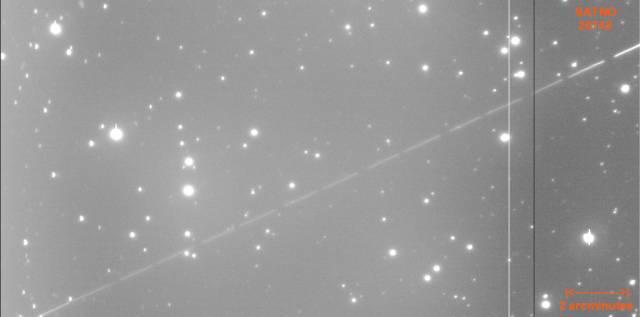NASA-LMT: Orbital Object Detection via CCD Sidereal Drift-scanning Mode
The detection of an orbiting object via
the sidereal mode of CCD operation. The CCD has been set such that its read
direction and read rate exactly match
the sidereal drift. A rotating asymmetrical beam chopper is used so that the
angular rate and direction may be
determined for any object passing through the FOV. The fixed rotation rate yields
either the object field crossing time
or segments of known duration, and the blade asymmetry yields a deterministic
pattern to the streak segments and gaps
(long and short) to yield direction of motion. In this example, the object is
Satellite Number 20472 which is an
operational Russian Molniya communications satellite (#1-78) in a highly elliptical
orbit with a RCS diameter of 4.45 m.
The object was at an altitude of 13,054 km with an angular velocity of 0.0388
degrees/sec, a position angle of motion
of 102 degrees, and a solar phase angle of only 36 degrees. Since the CCD
was sidereal drift-scanning, the object
signal photons were spread over the detector as it passed through the FOV,
rather than concentrated on several
pixels as with DM mode. The object exposure was 7.29 seconds based on its
angular rate and trail length, whereas
the field exposure was 97 seconds. The excess background exposure and
image spread contribute to a
significant reduction in SN ratio and thus a loss in sensitivity relative to DM mode
detections. Based upon the estimated flux above background
(127,000 ADU), coupled with the assumption of a
0.1 albedo and a specular phase
function, the object OCS based diameter is 2.00 m. This
white light image was
acquired with the LSP 2K CCD with 1x1
binning.
